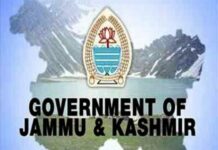Bilal Handoo
SRINAGAR

The day Kashmir commemorated 26th anniversary of Handwara massacre—that took place during Jagmohan’s stint as JK governor on January 25, 1990—the erstwhile controversial governor was awarded India’s second highest civilian award.
Jagmohan or Jagmohan Malhotra was given the Padma Vibhushan along with actor Rajinikanth, media baron Ramoji Rao and spiritual guru Sri Sri Ravi Shankar.
The award was announced today when Kashmir was observing the anniversary of Handwara Massacre—the second major post-armed uprising massacre— that saw BSF men killing 25 civilians, injuring countless. Till he was removed from governor’s post in May 1990, Jagmohan had become Kashmir’s most ‘hateful’ public figure.
But before his controversial tryst with politics would begin, this West Pakistan-born man migrated to India during 1947 partition as a seriously ‘sick boy’. Over the years, Jagmohan cut a tough administrator’s image for himself—the characteristic aptly cashed by the power centres, especially Indira Gandhi. His role in 1976 Turkman Gate massacre—an infamous case of political oppression in Delhi during emergency when police shot, killed people protesting against demolitions of their houses—is well reported. By supporting Indira’s moves on number of occasions, Jagmohan was sobriquet as ‘Indira’s pet’.
In Kashmir, Jagmohan’s first political brush began in 1984, when he got a call from Indira Gandhi to topple Farooq Abdullah government. Indira’s cousin and Jagmohan’s predecessor, BK Nehru clearly records Indira’s, Mufti’s and Jagmohan’s dubious roles in Farooq government toppling in his book, Nice Guys, Finish Second.
During his first tenure as JK Governor, Jagmohan is being credited for his civic works—especially laying ‘blacktops’ in parts of Kashmir. But in the garb of civic works, he stands accused to pass some controversial orders of setting up administrative units in state. One such creation was an independent board for Mata Vaishno Devi shrine—the move opposed tooth and nail by NC’s Farooq Abdullah and Congress’s Karan Singh and Ghulam Nabi Azad. But Jagmohan shrugged off the resistance of the high-profile trio while calling for the controversial creation.
By 1989, Jagmohan had become Rajiv Gandhi’s bête noire—after he didn’t oblige Rajiv’s directive to run for elections from Jammu. The denial led to their fallout.
In December that year, as VP Singh government took over Delhi, Singh’s home minister, Mufti Sayeed helped install Jagmohan as JK governor. Behind Mufti’s ‘Jagmohan juggernaut’ was their ‘good old’ Congress days spent together with “Madam” Indira Gandhi.
Jagmohan started his Kashmir comeback with a stern warning. And, what followed shortly became the dark chapter of Kashmir’s recent history. On January 19, 1990—the day he took over as JK governor, he was accused for facilitating Pandit migration from valley. On January 20, 1990, the governor-ruled Kashmir witnessed Gawkadal massacre in which 52 people were killed. On January 25, 1990, 25 civilians were killed by BSF in Handwara. On March 1, 1990, 33 killed at Zakoora, Tengpora. On May 21, 1990, at least 50 people killed as BSF fired on the funeral procession of Mirwaiz Moulvi Mohammad Farooq near Srinagar’s Islamia College.
By May 26, 1990, Jagmohan was removed as JK governor. Days before his removal, he made his Kashmir ambitions public in an interview: “Every Muslim in Kashmir is a militant today. All of them are for secession from India… The bullet is the only solution for Kashmir.”
In June that year, HM Mufti was defending Jagmohan’s Kashmir tactics in Delhi: “By sending Jagmohan to Kashmir we made major gains. He set up this nucleus of officials to fill the administrative vacuum.” For this, NC often jibes at Mufti-Jagmohan bonhomie—calling the duo, “brothers in crime”.
But Jagmohan’s ouster as JK governor never went well with him. Later he vented his feelings in his book ‘My Frozen Turbulence in Kashmir’—citing disagreement with various leaders in Janata Dal on Kashmir issue. However, the disgruntled Jagmohan was given Rajya Sabha berth (during 1990-1996) apparently for his iron-fisted rule in muzzling dissent in Kashmir. But later, Jagmohan had his own idea of revenge.
Years later, when he was appointed urban and housing minister, Jagmohan shocked many when he threw Mufti Sayeed—the man behind his Kashmir postings—out of his Delhi’s Tughlaq Lane bungalow!
















The most bone of contention of kashmir issues who raised up the the war at higher lavell and warmed up the blood of young children’s and youths of kashmir on the issue of hindwara massacre where teen age girls sisters mothers were brutally torched by rajputana forces he is the main cause of that issue